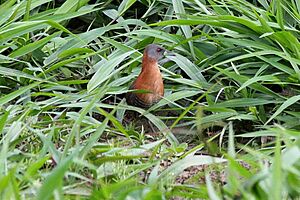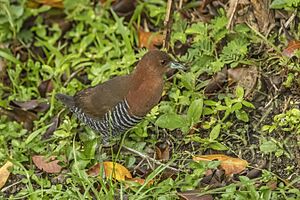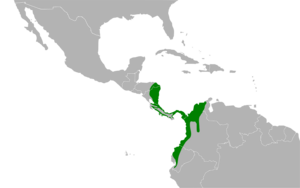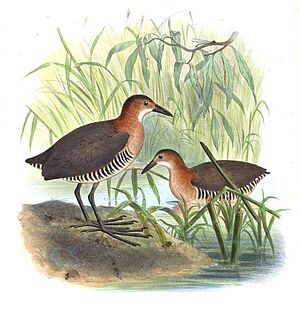White-throated crake facts for kids
Quick facts for kids White-throated crake |
|
|---|---|
 |
|
| With grey face, Costa Rica | |
 |
|
| Rufous-faced, Colombia | |
| Conservation status | |
| Scientific classification | |
| Genus: |
Laterallus
|
| Species: |
albigularis
|
 |
|
The white-throated crake (its scientific name is Laterallus albigularis) is a small, shy bird. It belongs to the Rallidae family, which includes birds like rails, gallinules, and coots. You can find this bird in parts of Central and South America, including countries like Colombia, Costa Rica, Ecuador, Honduras, Nicaragua, Panama, and Venezuela.
Contents
About the White-throated Crake
The white-throated crake was once thought to be a type of rufous-sided crake. But now, scientists agree it is its own unique species!
This bird has three slightly different kinds, called subspecies:
- L. a. albigularis
- L. a. cinereiceps
- L. a. cerdaleus
What Does It Look Like?
The white-throated crake is a small bird, about 14 to 16 centimeters (5.5 to 6.3 inches) long. Males usually weigh around 50 grams (1.8 ounces), and females are a bit lighter at about 45 grams (1.6 ounces). Both male and female crakes look very similar.
The most common type, L. a. albigularis, has a white throat and upper chest. Its face, neck sides, and lower chest are a reddish-brown color, called rufous. The top of its head and back are olive-brown. Its belly and under its tail have cool black and white stripes.
The other two types have different head colors:
- L. a. cinereiceps has a gray face.
- L. a. cerdaleus has a head and throat that are completely reddish-brown.
Where Does It Live?
White-throated crakes live in different areas across Central and South America.
- The L. a. albigularis type lives along the Pacific coast from southwestern Costa Rica and Panama, through northern and western Colombia, and into western Ecuador. Sometimes, one might even visit Peru!
- The L. a. cerdaleus type is found in northern Colombia and the very northwestern part of Venezuela.
- The L. a. cinereiceps type lives along the Caribbean coast from southeastern Honduras, through Nicaragua and Costa Rica, and into Panama.
These birds like to live in many different places, both wet and dry. You might find them in:
- Marshes
- Wet grassy fields and pastures
- Thick bushes
- Open areas in forests
- Along the edges of rivers and ponds
They can live anywhere from sea level up to about 1,600 meters (5,250 feet) high.
Craken Behavior
How It Moves Around
White-throated crakes usually stay in one area. But if it rains a lot, they might move to higher ground to stay dry.
What It Eats
This crake usually looks for food hidden in plants. But early in the morning, at dusk, or when it's raining, it might come out into the open.
Its diet includes:
- Insects
- Spiders
- Seeds from grass and sedges
- Algae
- Some small fruits
Reproduction and Life Cycle
The time of year when white-throated crakes lay eggs changes depending on where they live. They build a round nest from woven grass stems and leaves. The nest has a small opening on the side and is often placed in a bush or a clump of grass, either over water or on the ground. A female crake usually lays two to five eggs.
What Does It Sound Like?
The white-throated crake makes a sudden, loud, trilling sound that goes down in pitch. If it senses danger, it makes a sharp "chip" noise.
Conservation Status
The IUCN (International Union for Conservation of Nature) has looked at the white-throated crake and says it is a species of "Least Concern." This means they are not worried about it becoming endangered right now.
Even though it lives in a large area, we don't know exactly how many white-throated crakes there are or if their numbers are changing. There are no big threats to them right now. However, because they are very shy and hard to spot, it's sometimes difficult for scientists to know exactly how they are doing.



